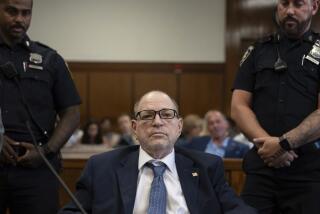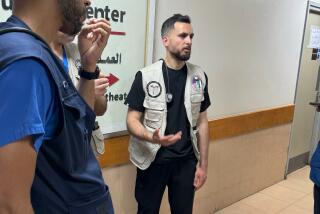At Bellevue, a hospital reflects its changing world
Yuzuro Yamamoto (not his real name) was a quiet Japanese man who knew only a handful of words in English, despite 30 years in America. He was a sturdy manual laborer, but over the last three weeks had been feeling weak.
One hand on the abdomen was all it took to know that his illness had been brewing for far longer.
Mr. Yamamoto’s belly had the smooth firmness of a pregnant woman’s, but he was 62 and male. It was a massive liver, and on the CT scan we could see that it had been entirely replaced by pale, pingpong-ball-sized masses. A biopsy of the nubby tissue protruding into his stomach confirmed metastatic gastric cancer that had gone entirely undetected until the very latest stage.
On that Friday evening, we sat with Mr. Yamamoto and his family, discussing what Stage IV cancer meant -- that there was no cure, that chemotherapy might prolong his life by weeks at best. We talked about grim end-of-life details: palliative care, healthcare proxy, “Do not resuscitate” orders. Mr. Yamamoto’s eyes followed our words as his son translated back and forth.
As we were having this painful conversation, Arnold Goldstein (also not his real name) was leaving the airport, having just made the trip from Miami to his home in Manhattan. As he made his way out of a taxi near Grand Central Station, he became dizzy, then collapsed from a heart attack. An ambulance brought him to the nearest hospital.
I met Mr. Goldstein as he lay in our cardiac monitoring unit just down the hall from Mr. Yamamoto.
Mr. Goldstein, a 68-year-old native New Yorker, was anxious to get to his private hospital. “I wasn’t expecting to end up in Bellevue,” he said, with noticeable trepidation in his voice. Bellevue Hospital, the oldest public hospital in the country, has a gritty reputation. Locals still recall the phrase “Send ‘em to Bellevue” from the “Barney Miller” sitcom of the ‘70s.
I explained to Mr. Goldstein why the first 48 hours after a heart attack require intensive monitoring, and why transferring hospitals at this stage wouldn’t be recommended.
“So I’m spending the weekend at Bellevue, eh?” he said. He gave a wry smile, as though this was going to be an urban war story he’d later recount over drinks with his friends.
Though city hospitals invoke images of charity patients from teeming, poverty-stricken slums, of substandard, last-resort medical care, the reality is quite different.
In my medical practice at Bellevue, I encounter a broad spectrum of patients. There are immigrants from all corners of the world -- taxi drivers, villagers, political activists, home attendants, street vendors. There are working-class New Yorkers whose jobs don’t offer health insurance. There are middle-class artists, musicians and writers who can’t afford insurance. There are homeless patients who live in shelters or on the streets.
Lately, I’ve had more professionals whose loss of job has been accompanied by loss of health insurance.
The next morning, I did my rounds on the ward. Mr. Yamamoto lay still, half-asleep, most of the time. His wife cupped his head and coaxed spoonfuls of miso soup in his mouth. He looked too exhausted to eat, but he seemed not to want to disappoint his wife, so he parted his chapped lips and took in a few drops.
Mr. Goldstein did laps around the ward, chatting gamely with the nurses and the orderlies and the physical therapists. I walked down the hall with him after lunch and tried to imagine how he was interpreting what we saw.
The hallways were bright and spacious. The floors were immaculately polished. The nursing station was a quiet hum of cardiac monitors and flat-screen computers.
The nurses were distributing medications from computer-controlled portable carts. Pagers at their waist were linked wirelessly to their patients’ cardiac monitors, alerting them to any irregular rhythms. White-coated medical teams in small huddles dotted the halls.
It looked nothing like the dilapidated, crumbling city hospitals of the 1970s urban-blight movies. Mr. Goldstein seemed comforted by the state-of-the-art facilities and the very ordinariness of the medical enterprise. He didn’t bring up transferring hospitals again.
Bellevue Hospital is synonymous in many people’s minds with “urban medicine” -- something that is not quite its own specialty yet but is growing as a concept of how health and medical treatment develop where large populations live in close proximity to each other, where ethnic and economic diversity are palpable.
With more than two-thirds of Americans living in urbanized areas, urban medicine is no longer an “inner city” phenomenon, though that still remains a key aspect. I’ve come to see urban medicine as a multifaceted mirror that reflects the rich and often bewildering complexity of modern society.
But it is also a looking glass trained on tomorrow. In some ways, it acts as a bellwether, since so many of society’s changes -- waves of immigrants, economic volatility, social trends, population shifts, emerging illnesses -- occur first in urban areas.
Being a “first responder” breeds a certain agility in the staff of urban hospitals. Clerical workers might be the first to know of a new immigrant group. Physicians may get firsthand news of political repression. ER nurses are often the first to pick up on newer illicit drugs in the community.
Monday morning, Mr. Goldstein got his echocardiogram, which showed that the heart attack had not done serious damage. He needed a stress test, but he could do that as an outpatient with his regular doctor.
Meanwhile, Mr. Yamamoto began to complain of pain and difficulty breathing. We started a morphine drip and he was immediately more comfortable, though he seemed smaller and more translucent.
As the sun stretched its bright noontime rays over the East River, while Mr. Goldstein strode out of the soaring glass atrium that is Bellevue’s elegant entranceway, Mr. Yamamoto died quietly in the hospital that has cared for so many generations of immigrants.
I charted my clinical summaries for both patients as the day waned, turning their cases over in my mind. There were such stark contrasts in their backgrounds and the course of their illnesses. I felt gratified that we’d been able to provide timely and appropriate medical care to both in their time of need.
Mr. Goldstein and Mr. Yamamoto seemed somehow emblematic of urban medicine -- diverse cultures, illnesses and socioeconomic situations pushed cheek-by-jowl against each other. Two men at the same stage in life, just a few doors down from each other, crossing paths in a hospital that is open to all.
Ofri is an internist in New York City. Her newest book is “Medicine in Translation: Journeys With My Patients.” She can be reached at author@danielleofri.com.
More to Read
Sign up for Essential California
The most important California stories and recommendations in your inbox every morning.
You may occasionally receive promotional content from the Los Angeles Times.










